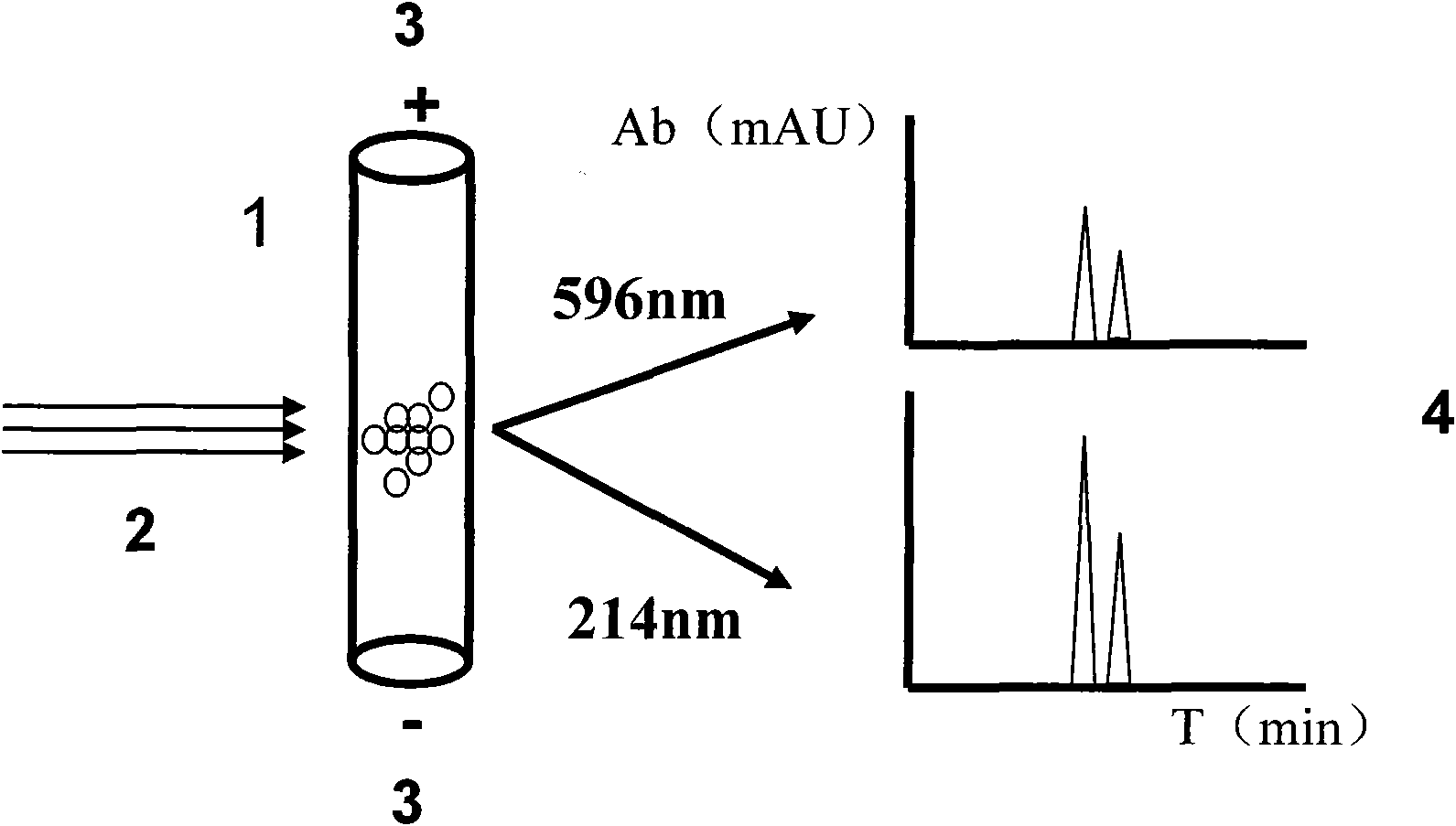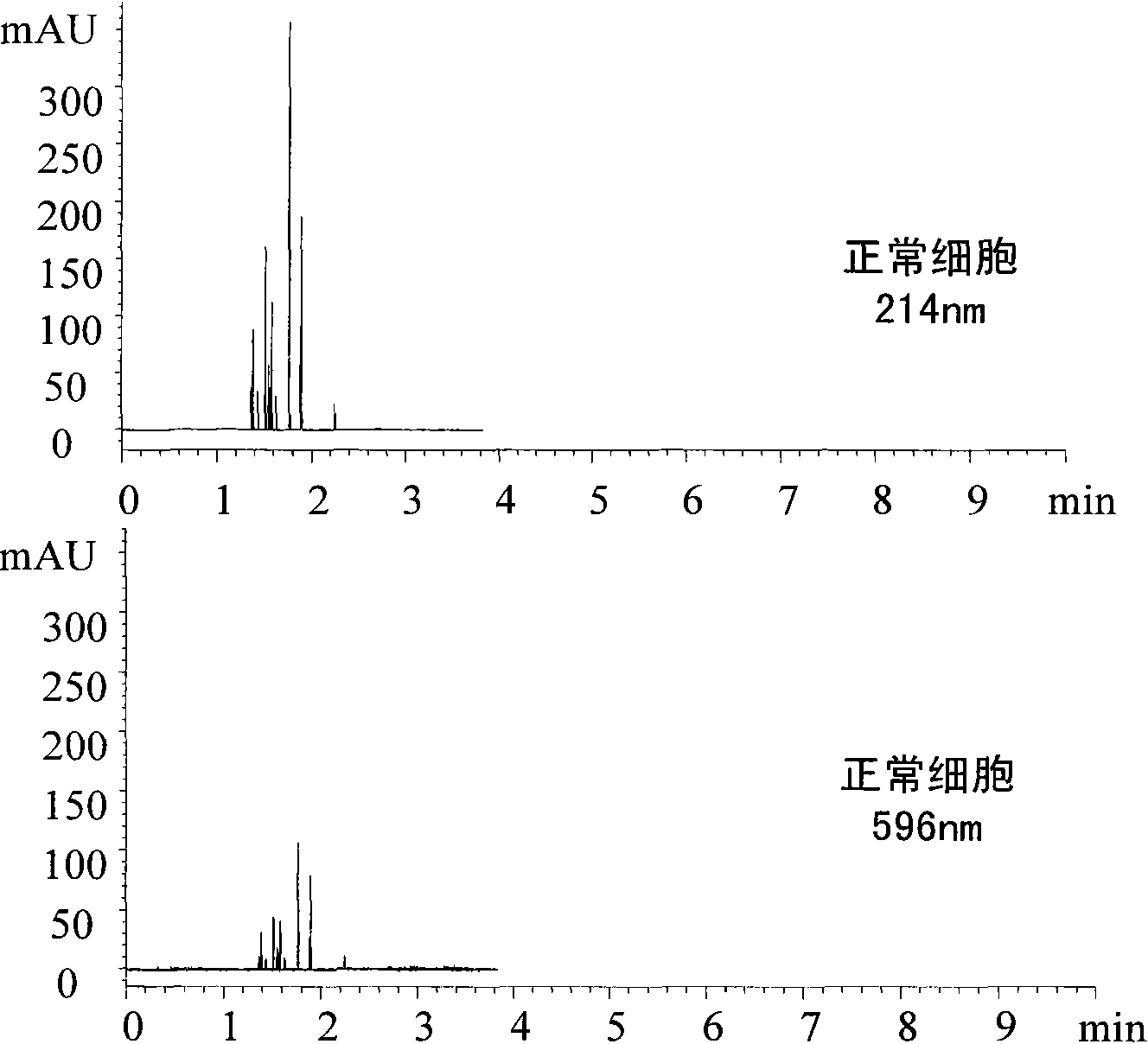Cytoactive detection method based on capillary zone electrophoresis mode
A technology of zonal electrophoresis and cell activity, which is applied in the determination/inspection of microorganisms, biochemical equipment and methods, color/spectral characteristic measurement, etc. It can solve the problems of high experimental cost, human error, expensive equipment, etc., and achieve storage The effect of long time, avoiding errors, high accuracy and sensitivity
- Summary
- Abstract
- Description
- Claims
- Application Information
AI Technical Summary
Problems solved by technology
Method used
Image
Examples
Embodiment 1
[0030] To culture 6 groups of Hela cells, you can use six-well plates or culture flasks with the same specifications. One group was used as the control group without induction agent, and the other five groups were added with methylmercury at concentrations of 2, 4, 6, 8 and 10 μg / ml respectively. at 37°C, 5% CO 2 The normal cell samples and the test cell samples induced by different concentrations of methylmercury were obtained by culturing for 12 hours under the condition.
[0031] Step 1. Pretreatment is performed on both the normal cell sample and the cell sample to be tested. That is, normal cell samples and cell samples to be tested were stained with 0.2 mg / mL Jiana Green for 10 min, centrifuged, and the supernatant was removed, and then phosphate buffered saline (PBS) was added to wash the cells until the residual Jiana Green Dye wash.
[0032] Afterwards, 200 μL of 4% formaldehyde solution was added to the washed cell pellet, thereby immobilizing the cells, and the i...
Embodiment 2
[0041] To culture 6 groups of Hela cells, you can use six-well plates or culture flasks with the same specifications. One group was used as the control group without induction agent, and the other five groups were added with methylmercury at concentrations of 2, 4, 6, 8 and 10 μg / ml respectively. at 37°C, 5% CO 2 The normal cell samples and the test cell samples induced by different concentrations of methylmercury were obtained by culturing for 12 hours under the condition.
[0042] Step 1. Pretreatment is performed on both the normal cell sample and the cell sample to be tested. That is, the cell samples to be tested were stained with 10 μg / mL Rhodamine 123 at 37°C for 10 min, centrifuged, and the supernatant was removed, and then the cells were washed with phosphate buffered saline (PBS) until the residual Rhodamine 123 was washed away.
[0043] Afterwards, 200 μL of 4% paraformaldehyde was added to the washed cell pellet to immobilize the cells, and the immobilization pro...
Embodiment 3
[0050] To culture 6 groups of Hela cells, you can use six-well plates or culture flasks with the same specifications. One group was used as the control group without induction agent, and the other five groups were added with methylmercury at concentrations of 2, 4, 6, 8 and 10 μg / ml respectively. at 37°C, 5% CO 2 The normal cell samples and the test cell samples induced by different concentrations of methylmercury were obtained by culturing for 16 hours under the condition.
[0051] Step 1. Pretreatment is performed on both the normal cell sample and the cell sample to be tested. That is, stain the cell sample to be tested with 0.1 mg / mL neutral red at 37°C for 10 min, remove the supernatant after centrifugation, and then add phosphate buffered saline (PBS) to wash the cells until the residual neutral red Red dye wash.
[0052] Afterwards, 200 μL of 4% formaldehyde solution was added to the washed cell pellet, thereby immobilizing the cells, and the immobilization process w...
PUM
| Property | Measurement | Unit |
|---|---|---|
| length | aaaaa | aaaaa |
| length | aaaaa | aaaaa |
Abstract
Description
Claims
Application Information
 Login to View More
Login to View More - R&D
- Intellectual Property
- Life Sciences
- Materials
- Tech Scout
- Unparalleled Data Quality
- Higher Quality Content
- 60% Fewer Hallucinations
Browse by: Latest US Patents, China's latest patents, Technical Efficacy Thesaurus, Application Domain, Technology Topic, Popular Technical Reports.
© 2025 PatSnap. All rights reserved.Legal|Privacy policy|Modern Slavery Act Transparency Statement|Sitemap|About US| Contact US: help@patsnap.com


